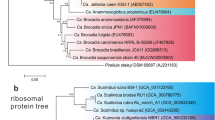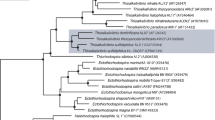Abstract
Benzoyl coenzyme A reductase (BCR) catalyzes dearomatization of benzoyl coenzyme A (benzoyl-CoA), which is the central step in the anaerobic degradative pathways for a variety of aromatic compounds. This study developed a PCR method for the detection and quantification of BCR genes in bacterial strains and environmental samples. PCR primers were designed by aligning known BCR genes in Thauera, Azoarcus and Rhodopseudomonas species, and their utility was assessed by amplifying BCR fragments from aromatic-hydrocarbon degrading anaerobes and other bacteria. BCR fragments with the expected sizes were obtained from denitrifying and phototrophic aromatics degraders. The positive signals were also obtained from Geobacter metallireducens and xylene-degrading sulfate-reducing bacterium (strain mXyS1) but not from other aromatics-degrading sulfate-reducing bacteria and aerobic bacteria. When the PCR was used for analyzing a natural attenuation (NA) site, the positive signal was obtained only from gasoline-contaminated groundwater; sequence analysis of these amplicons revealed that most of them exhibited substantial similarities to the known BCRs. Quantitative competitive PCR analysis estimated BCR-gene copies to account for 10–40% of bacterial 16S rRNA gene copies in the contaminated groundwater, indicating that bacteria possessing BCR genes were highly enriched in the contaminated groundwater. In microcosm bioremediation tests using the contaminated groundwater, the copy number of BCR gene was approximately 10-fold increased in the course of aromatics degradation under denitrifying conditions but not under sulfidogenic conditions. These results suggest the utility of the PCR method for assessing the potential of denitrifying bacteria for aromatic-compound degradation in groundwater.
Similar content being viewed by others
References
M Alexander (1994) Biodegradation and Bioremediation Academic Press Inc. San Diego, California 267–269
JG Becker G Berardesco BE Rittmann DA Stahl (2001) ArticleTitleSuccessional changes in an evolving anaerobic chlorophenol-degrading community used to infer relationships between population structure and system-level processes Appl. Environ. Microbiol. 67 5705–5714
HR Beller SR Kane TC Legler PJJ Alvarez (2002) ArticleTitleA real-time polymerase chain reaction method for monitoring anaerobic, hydrocarbon-degrading bacteria based on a catabolic gene Environ. Sci. Technol. 36 3977–3984
K Bendrat U Miiller A-G Klees W Buckel (1993) ArticleTitleIdentification of the gene encoding the activator of (R)-2-hydroxyglutaryl-CoA dehydratase from Acidaminococcus fermentans by gene expression in Escherichia coli FEBS Lett. 329 329–331
M Boll G Fuchs (1995) ArticleTitleBenzoyl-coenzyme A reductase (dearomatizing), a key enzyme of anaerobic metabolism, ATP dependence of the reaction, purification and some properties of the enzyme from Thauera aromatica strain K172- Eur. J. Biochem. 234 921–933
K Breese M Boll J Alt-Mörbe H Schägger G Fuchs (1998) ArticleTitleGenes coding for the benzoyl-CoA pathway of anaerobic aromatic metabolism in the bacterium Thauera aromatica Eur. J. Biochem. 256 148–154
JA Cunningham H Rahme GD Hopkins C Lebron M Reinhard (2001) ArticleTitleEnhanced in situ bioremediation of BTEX-contaminated groundwater by combined injection of nitrate and sulfate Environ. Sci. Technol. 35 1663–1670
PG Egland DA Pelletier M Dispensa J Gibson CS Harwood (1997) ArticleTitleA cluster of bacterial genes for anaerobic benzene ring biodegradation Proc. Natl. Acad. Sci. 94 6484–6489
K Fent (2003) ArticleTitleEcotoxicological problems associated with contaminated sites Toxicol. Lett. 140–141 353–365
G Filz M Widdowson JC Little (2001) ArticleTitleBarrier-controlled monitored natural attenuation Environ. Sci. Technol. 35 3225–3230
PD Franzmann WJ Robertson LR Zappia GB Davis (2002) ArticleTitleThe role of microbial populations in the containment of aromatic hydrocarbons in the subsurface Biodegradation. 13 65–78
M Hans J Sievers U Müller E Bill JA Vorholt D Linder W Buckel (1999) ArticleTitle2-Hydroxyglutaryl-CoA dehydratase from Clostridium symbiosum Eur. J. Biochem. 265 404–414
G Harms K Zengler R Rabus F Aeckersberg D Minz Ra Rossello-Mora F Widdel (1999) ArticleTitleAnaerobic oxidation of o-xylene, m-xylene and homologous alkylbenzenes by new types of sulfate-reducing bacteria Appl. Environ. Microbiol. 65 999–1004
CS Harwood G Burchhardt H Herrmann G Fuchs (1999) ArticleTitleAnaerobic metabolism of aromatic compounds via the benzoyl-CoA pathway FEMS Microbiol. Rev. 22 439–458
SR Hutchins DE Miller A Thomas (1998) ArticleTitleCombined Laboratory/Field Study on the use of nitrate for in situ bioremediation of a fuel-cntaminated aquifer Environ. Sci. Technol. 32 1832–1840
JA Klappenbach PR Saxman JR Cole TM Schmidt (2001) ArticleTitlerrndb: the ribosomal RNA operon copy number database Nucl. Acids Res. 29 181–184
S-Y Lee J Bollinger D Bezdicek A Ogram (1996) ArticleTitleEstimation of the abundance of an uncultured soil bacterial strain by a competitive quantitative PCR method Appl. Environ. Microbiol. 62 3787–3793
B Lin HW Verseveld Particlevan WFM Röling (2002) ArticleTitleMicrobial aspects of anaerobic BTEX degradation Biomed. Environ. Sci. 15 130–144
DR Lovley SJ Giovannoni DC White JE Champine EJ Phillips YA Gorby S. Goodwin (1993) ArticleTitleGeobacter metallireducens gen nov. sp. nov., a microorganism capable of coupling the complete oxidation of organic compounds to the reduction of iron and other metals Arch Microbiol. 159 336–344
R Margesin F Schinner (2001) ArticleTitleBioremediation (natural attenuation and biostimulation) of diesel-oil-contaminated soil in an alpine glacier skiing area Appl. Environ. Microbiol. 67 3127–3133
F Peters M Rother M Boll (2004) ArticleTitleSelenocysteine-containing proteins in anaerobic benzoate metabolism of Desulfococcus multivorans J. Bacteriol. 186 2156–2163
RC Prince (1993) ArticleTitlePetroleum spill bioremediation in marine environments Crit. Rev. Microbiol. 19 217–242
G Ritchie K Still J.3rd Rossi M Bekkedal A Bobb D Arfsten (2003) ArticleTitleBiological and health effects of exposure to kerosene-based jet fuels and performance additives J. Toxicol. Environ. Health. B. Crit. Rev. 6 357–451
KJ Rockne SE Strand (2003) ArticleTitleAmplification of marine methanotrophic enrichment DNA with 16S rDNA PCR primers for type II alpha proteobacteria methanotrophs J Environ. Sci. Health Part A Tox Hazard Subst. Environ. Eng. 38 1877–887
N Saitou M Nei (1987) ArticleTitleThe neighbor-joining method: a new method for reconstructing phylogenetic trees Mol. Biol. Evol. 4 406–425
JP Salanitro (1993) An industry’s perspective on intrinsic bioremediation In situ Bioremediation–When Dose it Work? National Academy of Science Washington, DC 105–108
J Sambrook T Zhou L Rhankin (1989) Molecular Cloning: A Laboratory Manual EditionNumber2 Cold Spring Harbor Laboratory Cold Spring Harbor, NY
AM Spormann F Widdel (2000) ArticleTitleMetabolism of alkylbenzenes, alkanes & other hydrocarbons in anaerobic bacteria Biodegradation 11 85–105 Occurrence Handle10.1023/A:1011122631799 Occurrence Handle1:CAS:528:DC%2BD3MXlsV2rtbo%3D Occurrence Handle11440245
JD Thompson DG Higgins TJ Gibson (1994) ArticleTitleCLUSTAL W: improving the sensitivity of progressive multiple sequence alignment through sequence weight, positions-specific gap penalties and weight matrix choice Nucl. Acid Res. 22 4673–4680
TM Vogel (1996) ArticleTitleBioaugmentation as a soil bioremediation approach Curr. Opin. Biotechnol. 7 311–316
K Watanabe K Watanabe Y Kodama K Syutsubo S Harayama (2000) ArticleTitleMolecular characterization of bacterial populations in petroleum-contaminated groundwater discharged from underground crude oil storage cavities Appl. Environ. Microbiol. 66 4803–4809
K Watanabe Y Kodama N Kaku (2002) Diversity and abundance of bacterial populations in groundwater accumulating in an underground crude-oil storage cavity 23 BMC Microbiol. 2
F Widdel R Rabus (2001) ArticleTitleAnaerobic biodegradation of saturated and aromatic hydrocarbons Curr. Opin. Biotechnol. 12 259–276
J Zhang TL Madden (1997) ArticleTitlePowerBLAST: a new network BLAST application for interactive or automated sequence analysis and annotation Genome Res. 7 649–656
Author information
Authors and Affiliations
Corresponding author
Rights and permissions
About this article
Cite this article
Hosoda, A., Kasai, Y., Hamamura, N. et al. Development of a PCR method for the detection and quantification of benzoyl-CoA reductase genes and its application to monitored natural attenuation. Biodegradation 16, 591–601 (2005). https://doi.org/10.1007/s10532-005-0826-5
Accepted:
Issue Date:
DOI: https://doi.org/10.1007/s10532-005-0826-5




